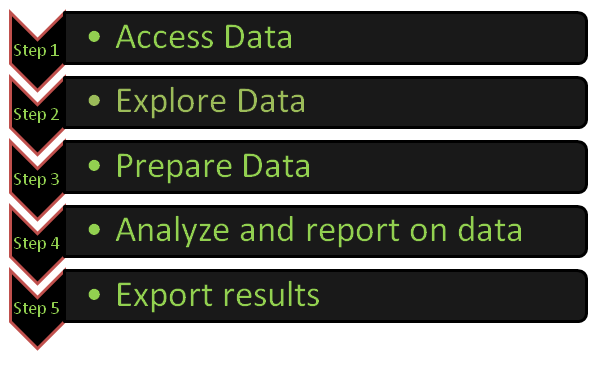SAS (Statistical Analysis System) is one of the most widely used software applications for data analytics and statistical analysis in various industries. Its wide range of functionalities and user-friendly interface make it a popular choice among data analysts, statisticians, researchers, and business professionals.
Toc
In this guide, we will take you through the essentials of SAS computer programming and how to master it as a data analyst. Whether you are new to SAS or looking to enhance your skills, this guide will provide you with a comprehensive understanding of the basic concepts and advanced techniques in SAS programming.
Introduction to SAS Programming for Data Analysts

In today’s data-driven world, mastering programming languages such as SAS (Statistical Analysis System) can significantly elevate a data analyst’s toolkit. SAS is a powerful and versatile programming language used extensively for data management, advanced analytics, multivariate analysis, business intelligence, and predictive analytics. This guide aims to introduce data analysts to SAS computer programming, highlighting its practical applications and real-world benefits.
Understanding SAS Programming
SAS programming is a high-level programming language that allows you to manipulate, analyze and report on data. It is a powerful tool for data management and analysis, with its own set of functions and procedures specifically designed for statistical analysis.
With SAS, you can import and export different types of data files, clean and transform data, perform statistical analyses, create graphs and charts, and generate reports. In addition to these basic functionalities, SAS also has advanced features such as macro programming, which allows you to automate tasks and create reusable code.
Advantages of Using SAS in Data Analysis
- User-Friendly Interface: SAS has a point-and-click interface that makes it easy to use for beginners and non-technical users.
- Comprehensive Documentation: SAS has extensive documentation, including manuals, tutorials, and online resources, making it easy for users to learn and troubleshoot any issues.
- Advanced Analytics Capabilities: With its vast array of statistical procedures and built-in functions, SAS allows data analysts to perform complex analyses with ease and accuracy.
- Efficient Data Management: SAS has efficient data management capabilities, enabling users to handle large datasets without compromising the performance of their system.
- Integration with Other Tools: SAS is highly compatible with other tools and applications, making it easy to integrate into existing data systems.
Learning SAS Programming
While there are various ways to learn SAS programming, the best approach is often a combination of self-study and formal training. Here are some tips to help you get started:
- Familiarize yourself with basic programming concepts such as syntax, variables, loops, and conditional statements.
- Explore SAS documentation and online resources to understand the syntax and functions used in SAS programming.
- Practice writing code by working on real-world datasets or participating in online challenges and competitions.
- Attend SAS training courses or workshops to gain a deeper understanding of the language and its advanced features.
- Network with other data analysts and SAS professionals to exchange knowledge and best practices.
Benefits of SAS Certification
- Professional Recognition: SAS certification is widely recognized in the industry and serves as a testament to a data analyst’s skills and knowledge. It can distinguish you from your peers and increase job opportunities.
- Enhanced Skill Set: Preparing for certification exams strengthens your understanding of key SAS programming concepts and introduces you to advanced methodologies.
- Career Advancement: SAS-certified professionals often see improved job prospects, higher salaries, and opportunities for career advancement.
- Access to Exclusive Resources: Certification grants access to a network of other certified professionals and exclusive learning materials, keeping you updated on the latest advancements in SAS technology.
- Continued Learning: SAS certification requires ongoing recertification, ensuring that certified professionals stay current with their skills and knowledge.
Practical Examples and Use Cases of SAS Programming

Some real-world applications of SAS programming in data analysis include:
1. Data Cleaning
SAS is renowned for its robust data cleaning capabilities, making it an excellent choice for handling large, complex datasets. For example, suppose a data analyst is working with a customer database that contains duplicate records. SAS can efficiently identify and remove these duplicates, ensuring the dataset is accurate and reliable.
Example Code:
“`
proc sort data=customer_data nodupkey;
by customer_id;
run;
“`
2. Statistical Analysis
SAS is widely used for statistical analysis in various fields, including healthcare, finance, and marketing. A common use case is conducting a regression analysis to understand how different factors influence sales in a retail setting.
Example Code:
“`
proc reg data=sales_data;
model sales = advertising budget / clb;
run;
quit;
“`
3. Predictive Modeling
SAS provides an excellent platform for building and testing predictive models. A financial institution, for instance, might use SAS to forecast loan defaults based on historical data, allowing them to mitigate risks more effectively.
Example Code:
“`
proc glmselect data=loan_data;
model default = income credit_score / selection=stepwise;
run;
quit;
“`
4. Report Generation
SAS excels at generating detailed and customizable reports, which can be automatically updated as new data becomes available. A data analyst might create monthly performance reports for a marketing campaign, offering insights into customer behavior and campaign effectiveness.
Example Code:
“`
proc report data=marketing_data nowd;
columns campaign month revenue;
define campaign / group;
define month / group;
define revenue / sum;
run;
“`
Real-world Case Studies in SAS Programming
Healthcare Analytics
SAS programming plays a pivotal role in healthcare analytics, providing solutions that enhance patient care and optimize operational efficiencies. One notable case study involves the use of SAS for predictive modeling in disease outbreak management. By analyzing vast amounts of historical patient data, SAS helps healthcare providers predict the likelihood of disease outbreaks, enabling timely intervention and resource allocation.
For instance, during a flu season, healthcare analysts might use SAS to forecast the number of expected cases based on variables such as previous outbreak patterns, vaccination rates, and demographic data. This predictive approach ensures that healthcare facilities are adequately prepared with necessary medications, vaccines, and staff.
Example Code:
“`
proc logistic data=flu_data;
model outbreak(event=’1′) = vaccination_rate population_density previous_cases / selection=stepwise;
run;
quit;
“`
Financial Analytics
In the financial sector, SAS is extensively utilized for risk management, fraud detection, and investment strategy optimization. Financial institutions rely on SAS to analyze transaction data, identify potential fraud, and mitigate risks effectively. For example, SAS can be used to detect unusual transactions that may indicate fraudulent activity, helping banks take corrective actions swiftly.
Example Code:
“`
proc anomaly data=transaction_data;
id transaction_id;
target amount;
outlier transaction_score;
run;
“`
Another significant application is in credit scoring, where SAS helps in building models that assess the creditworthiness of applicants, thereby reducing the risk of defaults and ensuring more accurate lending decisions.
Example Code:
“`
proc hpsvm data=credit_data;
class default;
model default = income debt_to_income_ratio employment_length;
run;
quit;
“`
Marketing Analytics
SAS is also a powerful tool in marketing analytics, where it is used to segment customers, analyze campaign effectiveness, and optimize marketing strategies. By leveraging SAS’s advanced analytical capabilities, marketers can gain deeper insights into customer behaviour, allowing for more personalized and effective marketing campaigns.
For instance, SAS can be used to segment customers based on purchasing behaviour, helping companies target their marketing efforts more precisely and improve customer retention rates.
Example Code:
“`
proc cluster data=customer_data method=ward;
id customer_id;
var purchase_history total_spent;
run;
“`
By integrating these insights with campaign data, marketers can measure the success of their marketing efforts and adjust strategies to maximize return on investment.
Job Opportunities for SAS

The strong demand for data analytics has made proficiency in SAS a highly valuable skill in the job market. Individuals with expertise in SAS programming can explore a myriad of career options across diverse industries.
Data Analyst
A data analyst who is proficient in SAS is responsible for gathering, processing, and analyzing large datasets to derive actionable insights. They work across various sectors, including finance, healthcare, marketing, and government, providing essential data that drives decision-making processes. These professionals leverage SAS tools to clean and organize data, conduct statistical analyses, and generate reports that help their organizations identify trends, solve complex problems, and optimize their operations.
Data Scientist
Data scientists use a combination of statistical methods, machine learning algorithms, and programming skills to analyze and interpret complex data. With SAS, they can build predictive models, conduct experimental analysis, and create data visualizations to support strategic decisions. The ability to handle big data and perform advanced analytics makes SAS-trained data scientists valuable assets in industries such as technology, retail, manufacturing, and more.
Business Analyst
Business analysts often use SAS to identify business needs and determine solutions to business problems. They play a crucial role in improving operational efficiencies and increasing profitability by analyzing market trends, customer behavior, and business processes. Their insights help guide strategic planning and business development initiatives, making them integral to the success of their organizations.
Clinical SAS Programmer
In the pharmaceutical and biotechnology industries, Clinical SAS Programmers are essential for analyzing clinical trial data. They create and manage datasets, perform statistical analyses, and generate reports for regulatory submissions. Their work ensures the accuracy and integrity of the data, thereby supporting drug development and ensuring compliance with regulatory standards.
SAS Consultant
SAS consultants provide specialized expertise to organizations needing advanced analytics solutions. They work on a project basis, helping businesses implement SAS software, develop analytical models, and train staff. Their role includes problem-solving, strategic consulting, and providing insights that drive business growth.
Future Trends in SAS

As the field of data analytics continues to evolve, several future trends in SAS can be anticipated. One prominent trend is the increasing integration of SAS with cloud-based platforms. Cloud computing offers scalability, flexibility, and cost-effectiveness, making it easier for organizations to manage large volumes of data and perform complex analyses without heavy upfront investments in infrastructure.
Another trend is the growing incorporation of artificial intelligence (AI) and machine learning (ML) capabilities within the SAS ecosystem. SAS is continuously adapting to include advanced algorithms and frameworks that enable sophisticated predictive modeling and automation of routine tasks. This integration will empower data scientists and analysts to derive deeper insights and make more accurate predictions.
Furthermore, the emphasis on real-time analytics is set to increase. With the rapid growth of Internet of Things (IoT) devices and the influx of streaming data, there will be a need for real-time processing and analysis. SAS is expected to enhance its tools to facilitate real-time decision-making, allowing businesses to respond promptly to dynamic market conditions and operational threats.
Lastly, user-friendly enhancements and improved interoperability are pivotal future trends. SAS is likely to focus on making its tools more accessible to users with varying degrees of technical expertise, fostering a democratization of data analytics within organizations. This includes more intuitive interfaces, seamless integration with other software, and enhanced visualization capabilities.
By staying abreast of these trends, SAS will continue to be a critical tool for organizations aiming to leverage data for strategic advantage. As the landscape of data analytics evolves, SAS will evolve with it, providing advanced solutions for businesses to stay ahead in competitive markets. So, learning and mastering SAS can open up a world of job opportunities and offer an exciting and dynamic career path.
Conclusion
SAS provides a robust framework for data analysis, enabling professionals across various domains to unlock the full potential of their data. Whether through integration with cutting-edge technologies like AI and ML or through enhancements in user accessibility, SAS remains at the forefront of the data analytics industry. The richness of features in SAS allows users to conduct sophisticated analyses, visualize complex datasets, and generate actionable insights that drive strategic decisions.
Continual learning and skill development in SAS can make individuals more adaptable and proficient in tackling modern data challenges. As organizations increasingly rely on data-driven strategies, the ability to harness SAS tools effectively becomes ever more critical. This underscores the importance of both newcomers and seasoned professionals in pursuing training and certification opportunities within the SAS ecosystem.
Moreover, SAS’s active community and extensive resources provide ample support for users at all levels. From comprehensive documentation and tutorials to user forums and professional networks, SAS users can collaborate, share knowledge, and solve problems collectively. This collaborative environment ensures that SAS remains not just a software tool, but a vibrant community dedicated to advancing the field of data analytics.
In summary, mastering SAS equips individuals with a competitive edge in a data-centric world, offering diverse career opportunities and the capacity to contribute meaningfully to their organizations. As data continues to be a cornerstone of modern business strategy, proficiency in SAS will remain a valuable asset in the dynamic landscape of data analytics.





